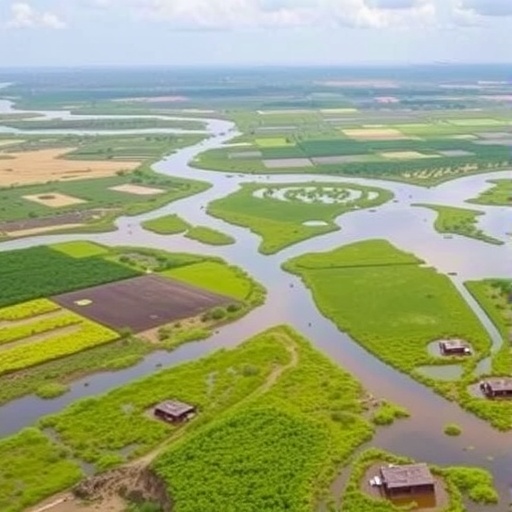In a groundbreaking study, researchers have explored the intricate dynamics of wetlands in the Lower Bilate River Basin, situated in Southern Ethiopia, over a significant period spanning from 1991 to 2022. The findings, published in the journal Discovery Sustainability, reveal vital information about the changes experienced by these ecosystems due to anthropogenic influences, climate variability, and natural processes. This research is pivotal, as it not only sheds light on environmental shifts but also sets the stage for future conservation efforts in a region where wetland resources are crucial for local communities.
The study employed advanced geospatial analysis techniques, which enabled the researchers to assess wetland coverage and its modifications throughout the three-decade time frame. They harnessed the power of satellite imagery and Geographic Information Systems (GIS) to meticulously track variations in wetland areas. Such methodologies have become essential in environmental science, allowing for an accurate understanding of habitat modifications and the factors driving these changes. Utilizing multi-temporal satellite data, researchers could capture not just the extent of wetlands, but also their health and functionality over three decades.
One of the striking findings of this analysis is the extent of wetland loss in the Lower Bilate River Basin. The researchers reported a significant reduction in wetland areas, attributed primarily to agricultural expansion and urban development. The rich biodiversity that thrives within these ecosystems is now under severe threat. Wetlands serve as invaluable resources for various plant and animal species, many of which depend on these habitats for survival. The reduction of these areas could lead to dire consequences for local fauna and flora, underscoring the urgent need for targeted conservation initiatives.
Additionally, the study highlighted the role of climate change as a complicating factor in wetland dynamics. Variability in precipitation patterns and increasing temperatures have created uncertain conditions for wetland viability. The research suggests that climate-induced alterations further stress the delicate balance of these ecosystems, making them even more vulnerable to human interference. The synergistic effects of climate change and land-use modifications pose significant challenges that need to be addressed through integrated management strategies.
As part of their analysis, the authors also considered the socio-economic implications of wetland degradation. Local communities rely heavily on the resources that wetlands provide, such as fish, water, and even medicinal plants. The loss of these ecosystems directly impacts livelihoods, exacerbating poverty and food insecurity. The interconnectedness of environmental health and human well-being is evident; restoring wetland ecosystems is not merely an environmental concern but also a socio-economic imperative.
To assist in steering policy decisions, the authors propose a framework for sustainable wetland management that involves local communities. Their recommendations emphasize the necessity of integrating traditional knowledge with scientific research to establish practices that are both culturally sensitive and environmentally effective. Community engagement is critical in these efforts, as local stakeholders have invaluable insights regarding ecosystem dynamics and use patterns that can guide conservation strategies.
Furthermore, the research discusses the potential for restoring wetlands in the Lower Bilate River Basin. Restoration initiatives can revitalize degraded areas, improving biodiversity and ecological function. The authors advocate for pilot projects that explore various restoration techniques, drawing on successful models from other regions. Such initiatives could stimulate ecological recovery while also serving to raise awareness about the importance of wetlands among local populations.
The findings of this study underscore a growing recognition of the necessity for proactive policies in environmental governance. The authors call for increased funding and resources dedicated to wetland conservation, ensuring that strategies are put in place to mitigate further loss and support rehabilitation efforts. Global cooperation and investment are crucial to bolster local initiatives and implement scalable solutions, particularly in light of ongoing climate challenges.
Moreover, this geospatial analysis contributes to a broader understanding of wetland dynamics across diverse geographies. Regions worldwide are facing similar threats from urbanization and climate change, making the findings from the Lower Bilate River Basin relevant to many areas globally. By showcasing methods that can be applied beyond the Ethiopian context, this research provides a valuable template for studies on wetland conservation efforts elsewhere.
In conclusion, the geospatial analysis conducted by Danano, Kabitiyimer, and Debele opens new avenues for understanding the complexity of wetland ecosystems in the Lower Bilate River Basin. Their work serves as a vital reminder of the interconnectedness between human activities and environmental health. As climate change and population pressures continue to rise, safeguarding these ecosystems becomes ever more critical. The insights gained through this research will not only aid in preserving local biodiversity but also contribute to the sustainable development of the surrounding communities.
In the end, the pressing call to action is clear: it is imperative that we prioritize wetland conservation not only for environmental sustainability but also for the well-being of future generations. As we forge ahead, let us remember that the health of our ecosystems is intrinsically linked to our prosperity, and the wisdom gleaned from studies such as this one is indispensable in navigating the challenges that lie ahead.
Subject of Research: Geospatial analysis of wetland dynamics in the Lower Bilate River Basin, Southern Ethiopia.
Article Title: Geospatial analysis of wetland dynamics in the lower bilate river basin, Southern Ethiopia (1991–2022).
Article References:
Danano, K.A., Kabitiyimer, S.T., Debele, M. et al. Geospatial analysis of wetland dynamics in the lower bilate river basin, Southern Ethiopia (1991–2022).
Discov Sustain 6, 1011 (2025). https://doi.org/10.1007/s43621-025-01609-8
Image Credits: AI Generated
DOI: 10.1007/s43621-025-01609-8
Keywords: wetland dynamics, geospatial analysis, Lower Bilate River Basin, Southern Ethiopia, environmental sustainability, climate change, conservation strategies, socio-economic impacts.




